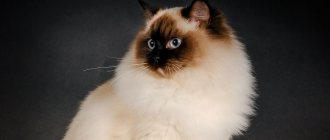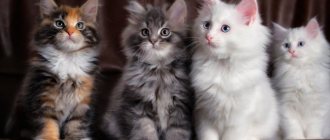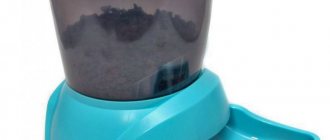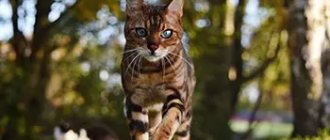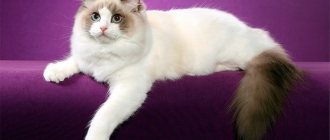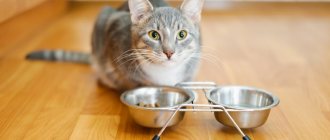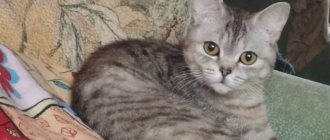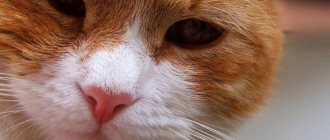Persian cat
The fur length of Persian cats can reach 12 cm
Very long, thick hair and a flattened muzzle have become the hallmark of the Persian breed.
When long-haired cats first appeared in the East remains a mystery to felinologists. Their ancestors were probably African wild cats. The first documented ancestors of the Persians were imported from Iran to Italy and France in the 17th century. The breed further developed in Europe. In 1889 it received official recognition in Great Britain.
In addition to external characteristics, Persians attract people with their confident character, sociability and habits; they are people-oriented and cannot live outside their home, but at the same time they can be stubborn and willful. They love attention to their person, tolerate children and guests, but do not have any special affection for anyone other than the owner. Offenses are not forgiven.
Persian cats have been used in the development of many other long-haired breeds.
Fluffy cats are not only valuable fur
A chic fur coat is the calling card of long-haired cats. It consists of two types of hairs:
- downy - shorter and thinner, forming the main volume in the form of undercoat;
- guard - long (more than 5 cm), thick and hard, forming the top layer and the shape of the coat.
Guard hairs protect the down and skin from getting wet and damaged. An important function of the undercoat is thermoregulation. It serves as a kind of thermos that maintains the animal’s normal body temperature in both cold and hot weather. Therefore, it is not recommended to cut long-haired dogs in the summer. The owner may think that taking off a hot fur coat will make the pet feel better, but a cat’s heat exchange is different from a human’s. Their heat escapes through the pads of their paws, and not through the entire skin. A shaved cat will overheat much faster than a shaggy one.
To help your fluffy in the heat, it is better to give him access to cool places - under the bed, behind the sofa, or spread a damp towel on the floor.
Himalayan cat
This breed was not named after its region of origin, but after the Himalayan rabbits due to their similar color and coat length.
Himalayan cats are the result of crossing Persian and Siamese cats. In the 20th century, many breeders tried to breed Siamese-colored Persians; in the 50s, the American Margarita Goforth succeeded in doing this.
Like Persians, Himalayan cats are calm, sociable, willful and intelligent, but a little more energetic. They love their owner's attention.
Mr. Cat recommends: popular breeds
The popular recognition of the breed is influenced by completely different factors than the official one. Subspecies that are affordable, widespread, and prolific (you don’t have to wait several years for a kitten) are becoming popular.
An easy-going and friendly character and the absence of difficulties with nutrition and care play an important role.
Thanks to the combination of positive qualities and the availability of purebred kittens with documents, Turkish Angoras, Maine Coons, Persians, Siberians, Norwegian Forest cats and all subspecies of Asian longhaired cats with a characteristic Siamese color become domestic fluffies.
Highland Straight and Highland Fold (Scottish Longhair cat)
Highland Straight and Highland Fold are long-haired varieties of the more famous Scottish Fold and Straight Shorthair cats.
To obtain more new colors, breeders included Persians, Exotics and Britons in Scottish cat breeding programs. With their blood came the recessive gene for long hair. At first, the fluffy kittens were discarded, but they were so beautiful that they could not stay away.
Thanks to the efforts of breeders and breed lovers, today most felinological organizations recognize the Scottish Longhair, allowing them to participate in exhibitions. Their character is no different from their short-haired counterparts. Highlands are gentle, kind and stress-resistant animals that do equally well in large families with children and with single people.
Buying a kitten
There is probably no more charming creature in the world than a small fluffy kitten - a gentle and touching bundle of soft, warm fur. However, all children tend to grow up quite quickly, and problems that at first might seem completely insignificant to you grow with them. A few tips to help you make the right choice:
- Do not be led by your emotions - do not buy a kitten spontaneously, succumbing to a completely understandable feeling of tenderness at the wonderful baby - you are not buying a soft toy, but a living creature that has its own character and its own needs.
The little fluffy ball will grow up soon, so it’s important to base your choice of a kitten on more than just cuteness
- You will need to take care of the kitten, educate, adapt, tolerate its pranks - it is quite possible that some problems associated with the new family member will not suit your family - be sure to consult with them and make only a collective decision.
- Try to learn as much as possible about the breed you like, prepare for the arrival of a kitten in your home, both theoretically and practically - purchase in advance everything you need for feeding, rest, hygiene and leisure for your baby.
How to choose
You need to decide in a timely manner not only about the breed, but also about the purpose of acquisition. Do you want a boy or a girl? Pet or show-class animal? The criteria for choosing a little furry will largely depend on your ambitions and financial capabilities.
But the main selection criterion always remains the same - you need to purchase a healthy animal with good heredity. It is clear that no one can give one hundred percent guarantees on these issues in advance, but buying a baby not on the market, but in a professional breeding nursery, still significantly reduces many risks. In addition, a responsible breeder will forever remain your friend and first mate.
Don't try to buy a kitten that is too small; The optimal age for moving him to a new home is 2.5–3 months, when the necessary vaccinations have already been completed and independent living skills have been acquired. If possible, look at the conditions in which your baby grew up, observe the habits and habits of his parents, brothers and sisters.
After two months, vaccinated kittens can move to a new place
The baby will get used to the new place quite quickly, and from the second or third day he will need to be taught the rules of life that you consider necessary. The sooner he learns them, the more positive and pleasant moments will appear in your life together.
Find mutual understanding with your baby as soon as possible
Video: fluffy kittens - all good
Cymric (Welsh cat)
For a long time, felinological associations did not want to recognize the tailless long-haired cat. Until now, many people call it just a variety of Manx
Manx is a breed of tailless cat that developed naturally on the Isle of Man, located near Ireland. They participated in exhibitions back in the 19th century. By the beginning of the twentieth century, the breed was already recognized in Europe and the USA. Among the short-haired Manx there were sometimes cats with long hair; Canadian breeders paid attention to them in 1976 and achieved official recognition, but under a different name - the Cymric cat.
The ancestors of the Cymrics were famous as excellent mousecatchers. The cats have not lost these skills. They are territorial and independent, not lacking in intelligence and can be aggressive if necessary. With close people they are calm and affectionate, moderately playful and curious.
Kymrik did not gain the popularity he deserved. One of the reasons lies in the difficulty of breeding. When crossing two tailless cats, there cannot be offspring, and when mating tailless and tailed cats, kittens are not always born that meet all breed standards.
Top 10 fluffy cats
All cat breeds, regardless of whether they are short-haired or long-haired, are divided into separate specific groups - Russian Aboriginal, British, Oriental, European and American. The Persian cat, as well as the exotic breed close to it, are considered truly long-haired. The remaining breeds are considered semi-longhaired, although they are called longhaired.
Russian natives are represented by the Siberian cat, British – by the British longhair, European – by the Norwegian forest cat, oriental – by the Turkish Angora, Burmese cat, Turkish Van and Japanese bobtail.
The group of American cats is represented by the following breeds of long-haired cats:
- Balinese cat.
- Maine Coon.
- York chocolate.
- Oriental cat.
- Nibelung.
- Ragdoll.
- Ragamuffin.
- Somalia.
- Selkirk Rex.
In addition to these breeds, other, no less popular breeds have long hair, such as the American Bobtail, American Curl, Himalayan, Javanese, Kimra, Neva Masquerade cat, including the Munchkin, Laperm, Napoleon, Pixie-bob, Chantally-Tiffany, Scottish and Highland Fold.
Top 5 fluffiest cats in the world
Persian cat
This is a breed that originated in Persia, according to experts, and is recognized by many felinological organizations.
It is believed that the first ancestors of Persian cats are Asian steppe and fluffy cats, as well as the manul cat. This breed appeared in Europe back in 1620. These animals had a wedge-shaped muzzle, and the frontal part was slightly cut off.
It is important to know! After some time, the Persian cat appeared in Great Britain, where it underwent serious breeding work. We can safely say that the Persian longhaired cat was the first to be registered in England.
This breed is distinguished from other breeds by its wide, snub nose. Some Persian cats have such a high-set mouth and nose that owners have to hand feed them because they are unable to feed themselves.
Siberian cat
Currently, this breed is also recognized internationally by many relevant organizations and clubs.
The ancestors are considered to be wild cats that lived in difficult conditions of long and harsh winters with a lot of snow. That is why these cats have excellent characteristics as a hunter who is able to overcome forest thickets, snow drifts, including water obstacles.
When people began to actively explore Siberia, the aboriginal breed began to cross with other breeds that began to appear in Siberia along with humans. As a result, the Siberian cat lost its individuality almost completely. The loss of individual qualities also occurred with individuals that were exported closer to the European part.
In the 80s of the last century, breeders began to purposefully restore the breed. After a certain period (in 1988), the first breed standards were announced, and after some time this breed began to be in demand among American breeders.
Norwegian Forest Cat
The breed, born in Norway, is considered no less recognized in all corners of the globe.
One version says that Norwegian forest cats descended from wild cats that lived in the forests of Norway, as well as from long-haired cats imported from Turkey. The cats managed to adapt to the extreme climate of Norway thanks to the presence of water-repellent fur and a powerful skeleton, as well as the presence of powerful muscles.
Interesting moment! At one time, breeders seemed to have forgotten that a similar breed of cats existed in nature, but then they realized that this was a unique breed for breeding work.
Breeders abandoned chaotic mating, preferring the targeted process of breeding such a breed back in the 30s of the last century. In 1938, the Norwegian Forest Cat was first shown at an exhibition in Oslo. After this, until 1973, this breed did not take any part in shows. During these years it was recognized in Norway, and after another 4 years it was officially registered by FIFe.
Kimra cat
The breed originated in North America and is officially recognized by such organizations as ACF, TICA, WCF and ACFA.
These are animals with a short back, massive and muscular thighs, and a dense, rounded body. The forelimbs are set wide apart and relatively small, while the hind legs are noticeably longer, so their structure is more suitable for the definition of “rabbit”. The breed differs from other breeds in the absence of a tail, while the hair is quite long.
Long-haired Manx were mainly kept in Wales, so the concept of “Welsh” was forever entrenched in the name of this breed.
American Curl
From the name itself it is clear where this cat breed comes from. It is recognized by such organizations as FIFe, TICA, CFA, and ACFA. The breed is noticeably different from other breeds in that its ears are curved backwards. The more distinct this bend is, the higher the class of the animal. In show class kittens, the ear has a crescent-shaped curve.
As far as we know, the breed originates from a single street cat whose ears had a unique shape. She was accidentally found in California in 1981. The cat was named "Shulamith". After some time, she had offspring, and some of the kittens had the same strange ears as their mother. In the case of crossing an American Curl with ordinary cats, kittens with ears turned back are born, but not all of them.
In 1983, the American Curl took part in the exhibition show for the first time and, a couple of years later, this breed received official status under the name of the short-haired variety of the American Curl.
Maine Coon
This breed also appeared in the USA and is officially recognized by many international organizations. These "Maine raccoons", if translated from English, resemble raccoons only due to their striped color. Experts say that when breeding this breed, such cat breeds as Oriental, British Shorthair, Scandinavian Longhair, and Russian were used.
Ordinary country cats, which are also considered the ancestors of this breed, were brought to the North American continent by the first colonists. After some time, Maine Coons developed thick hair, and they themselves increased in size, which contributed to the animals’ complete adaptation to the harsh conditions of North American latitudes.
In 1861, in New York, the first Maine Coon took part in an exhibition show, but the breed was not very popular and only in the middle of the last century Maine Coons gained widespread popularity. In 1976, the CFA approved breed standards. Currently, this breed is in demand both in its homeland and abroad.
Ragdoll
The USA is also the birthplace of such cats. The breed has official status and is recognized by many felinological organizations.
Ragdolls are the result of crossing a Burmese cat and a white longhaired cat from California. Thanks to the efforts of breeder Anne Baker, who purposefully worked with animals with a gentle, good-natured character, as well as the ability to relax muscles.
This breed requires attention, protection, and special care, since it has practically no instinct of self-preservation. In 1970, this breed received official status. These days the breed is very popular.
Important point! Americans try to breed ragdolls with traditional colors. In comparison, Europeans practice registering cats with non-standard colors.
British longhair cat
Despite the fact that this cat breed originated in Great Britain, it is ignored by many English breeders because it contains the long hair gene. The American CFA also shows solidarity with its English colleagues on this issue. For some reason they believe that British cats should be exclusively shorthaired.
However, the British Longhair is very popular among breeders in other countries, as well as in the International Cat Federation (FIFe). The behavior, as well as the exterior, of this breed almost completely corresponds to the British Shorthair cat breed, and therefore received all the rights to participate in various exhibition shows.
Turkish van
Türkiye is considered the birthplace of this breed, as is clear from its name. Recognized by many clubs and organizations.
A distinctive feature of this breed is the presence of membranes between the toes of the forelimbs. In addition, the body is covered with thin, long, waterproof hair.
The name of the breed comes from Lake Van, since the province where this breed originated borders this lake. In ancient times, these cats were found not only in Turkey, but also in the Caucasus.
The breed appeared in Great Britain in 1955, after which intensive breeding work began. By the beginning of the 60s, the cat’s exterior was already ready, but for almost 10 more years this breed was considered experimental. The GCCF legitimized this breed only in 1969, and a year later the FIFe did so.
Ragamuffin
The birthplace of this breed is the USA, and it has received recognition in organizations such as ACFA and CFA.
Ragamuffins are very similar to Ragdolls, but have a wider range of coat colors. These animals do not have hunting instincts; in addition, they are not able to fend for themselves. As a rule, these cats coexist peacefully with other pets.
Interesting moment! The period of origin of this breed is still unknown. Experts believe that ragamuffins, which means “ragamuffin”, were obtained by crossing ragdolls with ordinary yard cats.
The breeders' work was aimed at producing ragdolls with more diverse and unique colors. As a result, a completely new breed of cats was born, which took part in an exhibition show in 1994. Only in 2003, this breed was legalized by the CFA.
Fluffy cats Cat breeds
Selkirk Rex
Interestingly, the quality of the curl of the Selkirk Rex is influenced by the season, heredity and age, so each representative of the breed is unique
This is one of the most unusual long-haired cat breeds. The history of the Selkirk began in America in 1987, when a pregnant domestic cat was brought to a small shelter. Soon she gave birth to 6 kittens, one baby had very beautiful green eyes and curly hair. He became the founder of a new breed.
By nature, Selkirk Rexes are calm, patient, affectionate and silent, they are playful and intelligent, they sense the mood of their owner well and do not tolerate loneliness well.
Content Features
When purchasing a nice fluffy kitten, you need to be aware in advance that you will have to take a lot of constant care for its fur. Accordingly, you will need to accustom your baby to regular combing from the, as they say, youngest claws. This approach will subsequently save both the animal and you from many problems.
Grooming
It is imperative to take care of your cat's fur, regardless of its length. But long and thick fluffy wool, of course, requires special attention. Most cats don’t like bathing too much, but you shouldn’t get upset because of this and try to force your pet into the shower, especially if she is clean by nature and is used to carefully licking her own coat.
It is enough to bathe the cat as the fur becomes dirty - when it becomes dusty, dirty or sticky. For local contamination, you can use various cleansing wipes; dry shampoos also help. The range of modern cat hair care products is very large, from which you can always choose something that is ideal for the specific characteristics of your pet’s hair. Do not experiment with human shampoos - they are not suitable for cats.
The sooner you teach your furry to be hygienic, the better.
Brushing for a fluffy cat is a very important procedure, much more important than bathing. In those places where softer fur grows - usually on the stomach, armpits, neck and groin - it often gets confused and can reach the sad state of felt, which becomes impossible to comb, all that remains is to cut it off.
Please note that this is not only an aesthetic problem - neglected furries suffer from skin diseases, itching, allergies, and eczema. They feel extremely uncomfortable, so they can refuse food, become depressed and even become seriously ill.
If you don’t comb the tangles in time, you can only get rid of them in a radical way.
In most cases, brushing a long-haired cat once or twice a week is enough, but there are breeds for which grooming should become a mandatory daily ritual. A groomer's mandatory home kit should consist of the following tools:
- fine metal comb;
- “rake” comb with rotating teeth;
- slicker;
- furminator.
If you cannot cope with caring for your pet’s coat on your own, regularly seek advice and practical help from professionals.
Photo gallery: fashionable haircuts and hairstyles for a fluffy cat
Most often, Persians are shaved radically - “like a lion”
The “Puss in Boots” haircut is one of the most popular
This is how you can make a dinosaur out of a cat
A glamorous hairstyle option - only for girls. On thick red fur, such grooming is especially effective
This hairstyle is suitable even for the most brutal macho man
Video: how to care for cat fur
Tendency to diseases
Fluffy cats get sick just like all others, but these breeds are more prone than any other to various skin diseases. Such ailments can be caused by an incorrect diet:
- poor quality or unbalanced menu;
Treats from the master's table are not food for your pet
- lack or, conversely, excess of vitamins;
- overfeeding and physical inactivity.
A timely visit to the veterinarian will help avoid many problems.
Do not neglect the advice of the breeder and veterinarian - they will help you optimize your pet’s nutrition and improve its metabolism. This will improve not only the condition of the animal’s coat, but also its overall health. But every owner is capable of taking care of his pet’s hygiene - initially make such procedures regular.
Reproduction
Breeding work is a very responsible process, and it should definitely be done by professionals.
Do not breed your pets “for health” - this is a thoughtless and incorrect approach to breeding animals, especially purebred ones. This is how a huge number of animals with bad heredity appear, and mixed breeds, which sooner or later may turn out to be of no use to anyone and end their lives in the trash heap.
For fluffy cat breeds, it is especially important, under the supervision of your breeder, to choose the right parent pair. The strategic goal of mating must necessarily be preservation in the offspring, and ideally, improvement in the quality and structure of the coat, as well as other breed qualities. Both producers must be completely healthy, vaccinated and promptly treated for parasites.
Entrust the choice of parent pair to an experienced breeder
Just before mating, do not forget to trim the hair around the genitals of the future parents short - this will make the process more hygienic and reduce the risk of injury to the animals.
Siberian cat
The long hair of Siberian cats is considered relatively hypoallergenic
The Siberian cat is the pride of Russian felinology. This is a distinctive breed that was formed under the influence of environmental conditions. Such cats were first mentioned in the chronicles of the Trans-Ural region of the 16th century. Then they were called Bukhara. They probably appeared as a result of mixing the blood of ordinary domestic and wild cats.
By nature, Siberian cats are bold and courageous, act decisively, love freedom, walks and hunting. Not the best option for living in an apartment.
Kurilian Bobtail (15)
The Kurilian Bobtail is the fruit of love between Siberian cats and Japanese Bobtails, which fate brought together on the territory of the Kuril Islands. The fluffy cat with a tail and a belly button like a hare has independently developed and reproduced since the 17th century, but received a standard only in 2012, when TICA surrendered under the pressure of felinologists.
Sexual dimorphism is inherited from Siberians: cats up to 4.5 kilograms, males up to 7.5 kilograms. The body is squat, but with a strong muscular frame, allowing the breed to jump very high. The gradation of the tail within the breed is interesting - the longer the coat, the larger the tail can be. Long-haired representatives of the breed have a tail that can be up to 13 centimeters.
By its nature, the cat can even be called a watchdog - it is ready to protect its family in all seriousness, hissing and rushing at uninvited guests. And in games, a bob-tailed fluffy cat is like a dog - playing with a ball is the best entertainment for it.
Norwegian forest
The Norwegian Forest Cat is a national treasure of the northern country.
Until 1938, the Norwegian Forest Cat was not mentioned in any official source, although its ancestors are believed to have appeared in Viking times.
Despite the name, the forest cat is not obstinate at all, like a wild animal; it is affectionate, devoted, affectionate, sociable, very quiet and obedient. The only thing that remained in her from the forest was her love of hunting... butterflies.
Ragdoll
Interestingly, all Ragdoll kittens are born white, their color begins to appear only at the age of 8-10 weeks, and full color is formed by 3-4 years
Translated from English, the name of the breed means “rag doll.” And indeed, these cats are a model of relaxation. They are always relaxed and do not show aggression, obedient and calm. This amazing submissiveness has led to the myth that Ragdolls are resistant to pain or unable to support their paws. This is wrong.
Ragdolls were bred in the United States in the early 60s of the 20th century by Persian cat breeder from California Ann Baker. Her goal would be to produce a breed that would have a gentle disposition and could completely relax in the hands of a person. The founders were selected primarily by character. According to the author's idea, the breed was to be called Cherub.
Turkish Angora
The graceful Turkish Angora with unusually delicate fur is one of the oldest cat breeds. Many cat lovers consider only white cats to be “real” Angoras, but the standards allow for different colors, including black.
Several centuries ago, an Angora kitten was considered a very expensive and prestigious gift, worthy only of noble people. Angoras were popular until the beginning of the last century, until a new star rose in the firmament of felinology - the Persian cat. Angoras have fallen out of favor and are now among the rarest cat breeds.
Ragamuffin
Translated from English, the name means “ragamuffin”. This breed was obtained by crossing Ragdolls with Persians, Himalayans and mongrel cats.
The Ragamuffin is a relatively young breed that was first presented at an exhibition in the mid-90s. Received official recognition in 2003. The origins of the breed were the same breeder who created the Ragdoll.
Ragamuffins are calm, playful, affectionate and smart cats that easily adapt to any living conditions, love to sit in arms, and do not resist human actions. They do not welcome yard life, they are very trusting and harmless. Older Ragamuffins may darken their color with age.
Somalia
Long-haired Abyssinians have a flexible body, long limbs, a red coat and a bushy tail. Fluffy “fox” cats with a sly, sharp muzzle and a curious, slanted look. Due to high activity, injuries are common. They are prone to kidney disease - kittens are tested for polycystic disease every year.
Somalis are active, curious cats who are interested in everything. They deftly climb into the most unexpected places, quickly learn to open doors and cans, and literally stick their noses everywhere. Tireless friends for children, playful and harmless. They are attached to the whole family and are always happy to have company. Interactive toys, a gaming complex, and a second cat will help you survive loneliness.
Nibelung
The only difference between the Nibelung and the Russian Blue is the length of the coat.
Gray-blue Nibelungs with long silky fur look incredibly beautiful. Their name means "children of the mist" in Scandinavian. By the age of one year, a green ring around the pupil becomes noticeable.
Nibelungs have a calm, pleasant disposition. These are kind, gentle cats that do not like change and become strongly attached to one person.
Gray breeds of cats and cats: photos, description of character
Gray cats always look elegant and aristocratic. This color is called “blue”, and varies from light ash to dark gray. Blue cats should be distinguished from smoky cats. The latter have white fur at the base.
There are several breeds that are exclusively gray in color:
Chartreux (Carthusian cat ) is a fairly large, strong animal with amber eyes.
The following characteristics are typical for cats of this breed:
- easily adapt to any conditions
- obedient and easy to train
- playfulness alternates with periods of calm
- not intrusive
- not prone to pranks
- are attached to a person, not to a habitat
- choose one owner who is accompanied everywhere
- love affection and stroking on the head and cheeks
- they treat strangers rather indifferently
- love space and walks
Chartreuse (Carthusian cat)
Russian Blue is a popular, expensive breed. It has a thick, dense, shiny coat of uniform blue color with a silver tint. Has an elegant and slender body.
This proud cat with character has its own characteristics:
- a little stubborn and freedom-loving, but at the same time obedient
- kind and affectionate
- can spend the whole day at home alone
- unobtrusive, but happy if you take her for a walk
- sits with pleasure in the arms of the owner, and only when she wants it
- curious and observant
- wary of strangers
- doesn't like closed doors
- homebody
- loves to hunt
Russian blue
The Korat is an ancient breed native to Thailand, where these animals are considered a symbol of happiness. In appearance they are similar to Russian Blue cats. The only recognized color is blue with silver tips. It is distinguished by large and bright emerald or amber eyes.
They have a specific character:
- do not like cats of other breeds around them
- jealous and really miss the owner in his absence
- don't like strangers
- males are known as fighters, but at the same time they show themselves as caring fathers
- don't like long walks
- are homebodies and rarely leave the house
- good-natured and reserved
- playful
- require increased attention
Korat
British Blues are robust cats with a round head, small ears and a wonderful short, thick coat. This cat is the embodiment of British aristocracy:
- hardy and strong
- friendly and approachable
- patient, gets along well with children or other animals
- does not like familiarity
British blue
The Nibelung (“child of the fog”) is a rare breed, graceful owners of silky soft fur and emerald eyes. Long-haired version of the Russian Blue.
They have a rather unique character:
- not very sociable
- may be aggressive towards strangers at a young age
- everyone understands, but loves to do it their own way
- quite cunning
- affectionate with the owner and household members
Nibelung
Red breeds of cats and cats: photos, description of character
Red cats were considered in Rus' a symbol of the sun and happiness. And in some countries such animals are associated with financial well-being.
The red color in felinology is called red. It is worth noting that there are no animals with a uniform red tint; this color is always heterogeneous, with impurities, decorated with stripes and spots. It is believed that the more spots or stripes an animal has, the more complex its character.
The temperament of red cats is always individual, and the character depends not only on the breed, but also on the owner’s attitude towards the animal. However, the common features of all “saffron milk caps” are:
- insolence
- courage
- cunning
- demand for increased attention to one's person
- mischief and playfulness
Red color is especially common among representatives of “wild” breeds.
Caracal is a steppe lynx. A predatory animal that can only be tamed if raised in captivity.
Peculiarities:
- curious and playful
- difficult to train due to wild temperament
- requires an attentive, patient attitude, especially in the first two years of life
- devoted to the owner
- feels good in a private house with a spacious enclosure
Caracal
The Abyssinian cat is one of the oldest breeds, the ancestor of which is African cats. It has a ticked reddish color (sorrel). However, blue and fawn can be found. The breed is distinguished by its small number of offspring.
Main character traits:
- obstinacy
- intelligence and curiosity
- melodious voice
- mobility and energy
- extreme love of games and space
- sociability, it is difficult for such a cat to be alone
Abyssinian cat
The Bengal cat is the result of crossing domestic cats with leopard breeds. Owners of reddish fur with spots. Silver color is less common.
The character combines wild and “domestic” traits:
- very energetic, attack everything that moves
- smart and quick-witted
- do not like tactile caresses
- quickly get used to people and conditions
- loyal to the owner, but sometimes distance themselves from him, preferring loneliness
- wary of strangers
- get along well with other animals
Bengal cat
A bright sunny shade is often found in more familiar pets:
- Persians
- British
- Siberian cats
- maine-coons
Neva Masquerade
Neva masquerade cats began to be bred in St. Petersburg under the leadership of breeder Olga Mironova.
This cat breed was bred in the city on the Neva and is a variety of Siberian, from which it differs in its beautiful color-point (Siamese) color. Neva masquerade cats often have blue eyes. They got their name because of the darkening on their muzzle, reminiscent of a mask.
The Neva Masquerade is valued not only for its beauty. She has a calm character and a healthy psyche. The cat is discreet, fearless, patient. She has a developed sense of self-esteem, loves attention, but is rarely intrusive.
How many furry breeds are recognized by FIFe, WCF, CFA
There are three world organizations that assign official statuses to various newly developed cat breeds: FIFe, WCF and CFA. The number of breeds that have been registered by the relevant organizations is distributed as follows:
- The World Cat Organization (WCF) has legitimized about 70 breeds.
- There are 42 breeds registered by the International Cat Organization (FIFe).
- About 40 cat breeds have received official status from the Cat Fanciers Association (CFA).
Typically, the data is constantly updated as some breeds are repeated, although called differently, and some breeds are developed and added to the list from time to time.
Important point! The third part (31 breeds) of long-haired cats are distinguished by the fact that they have their own standard, therefore they have permission both for breeding work and for exhibition shows.
Highlander
The British Longhair is a variety of shorthaired cats, which is recognized by some associations as an independent breed.
More recently, the British Longhair has been recognized as a separate breed called the Highlander. They are valued for their calm, affectionate disposition and, of course, appearance.
As befits a Briton, the Highlander is quite capricious, but this is by no means a minus. It is the bright personality that attracts many to this breed.
The main differences between purebred cats and yard cats
A purebred cat always has one or more distinctive characteristics that allow it to be classified as a particular breed. This could be an interesting color, unusual ear structure, iris color, etc.
These qualities are fixed by the standard, so representatives of the same breed are quite similar to each other. But the differences between cats of different breeds can be dramatic.
Non-pedigree cats differ much less from each other in appearance. They can be identified by the following unifying characteristics:
- medium-sized, high-set triangular ears sticking straight up;
- regular shaped round head;
- elongated, graceful body of correct proportions;
- muscular, long paws with soft pads and sharp claws;
- well-set round eyes;
- an energetic and agile long tail that well expresses all the cat’s emotions.
Minuet (obsolete Napoleon-minuet)
These cats have nothing in common with cake, commander or cognac. To dispel all doubts, the title was shortened to "minuet", but the old version is still quite common
The author of the breed is John Smith, an American breeder who began working on his own breeding program in 1995. He crossed munchkins with Persians. The main distinguishing features of the breed are short legs and long hair, but, like munchkins, minuettes are often born with legs of a standard length.
Minuets are exclusively domestic; they do not need free range. By nature they are calm, affectionate, sweet, playful and curious.
Breeds not included in the top ten
There are several more interesting, long-haired cat breeds that are worth mentioning.
Nibelung
This breed originated in the USA and is one of the variations of the Russian Blue cat. European breeders noticed that short-haired blue cats gave birth to long-haired kittens, although they were discarded, considering them a breed defect.
Interesting fact! As for American breeders, they acted differently, turning this breed flaw into an advantage. At the same time, they began to purposefully breed long-haired blue cats.
The coat's characteristics are similar to those of Balinese cats, although it is even more delicate and softer. The name of the breed is associated with one of the ancestors, nicknamed the cat Siegfried. In 1987, the official presentation of this unique breed was made.
LaPerm breed
This breed was also born thanks to breeders from the USA.
These are animals that can have straight or wavy hair. After birth, the coat changes several times during 1 year of life. It is believed that the breed originated in 1982 on a Dallas farm. The kitten was completely naked when it was born, but after a couple of months it was covered with interesting curls. These coat characteristics were passed on to future offspring. As a result, many individuals with a unique coat were born, which began to represent a new breed called Laperm. In 1996, this breed was officially registered under this name.
Napoleon
Thanks to the efforts of American breeders, another breed of long-haired cats saw the light of day. American Joe Smith practiced breeding Basset Hounds. In 1995, he decided to improve the Munchkin by crossing it with a Persian cat. He assumed that thanks to the Persian cat the breed would have a charming face and long hair, and thanks to the Munchkin the cat would have an overall diminutive appearance and short limbs.
Interesting to know! Despite the fact that this work was associated with some difficulties and failures, it was still possible to develop a breed with the expected qualities and without the presence of breed defects.
First, the breed was recognized by TICA, and after a while ASSOLUX. As for other clubs, they began to classify her as a munchkin variety, after which Smith decided to stop breeding work and destroyed all documents. Despite this, some enthusiasts continued their work and got a cat with a pleasant appearance. In 2015, Napoleon was renamed minuet.
Top 5 Fluffiest cats in the world. Gorgeous cat breeds
Bohemian Rex
In fact, the Bohemian Rex is also a Persian cat, but with curly hair
Another name for the breed is the Czech curly cat. It is considered relatively young and is so far recognized by only a few associations as experimental.
The “Bohemian” story began in the 80s in the Czech Republic. The curly-haired kittens that sometimes appeared in litters of Persian cats became of interest to breeders and they decided to consolidate the original trait. The Persians probably inherited the curly hair gene from Hermann rex.
The breed has not become widespread and remains very small even in the Czech Republic.
Sacred Burma
The cat breed of harmonious build, with a stylish color-point color and a catchy, even solemn name, is one of the very few recognized by absolutely all felinological systems. As you might guess, thanks to the uniqueness and beauty of its appearance. The calling card of the breed are neat snow-white “shoes”, as if worn on dark stockings. Burmese have a poorly developed undercoat, but a rather fluffy “collar” and tail. Bright blue eyes complete the look.
The history of the Burmese began in the 20s of the last century, but reliable information about the ancestors of the breed has not been preserved. The legend about the origin of the Burmese from amazing cats that allegedly lived in a Buddhist monastery in Burma is very touching, but implausible. However, the beautiful name stuck and even contributed to the popularity of the breed.
Burmese cat
One of the most beautiful and mysterious breeds
According to legend, the Burmese cat appeared in a Buddhist Temple, where the blue-eyed goddess Tsun-Xuanxa was worshiped. The monks believed that their pets helped in the transmigration of souls. At the beginning of the 20th century, a pair of cats stolen from a monastery ended up in France. The new breed won the hearts of cat lovers and was soon officially recognized.
A distinctive feature of Burmese cats is the color of their long, soft coat. It is uniformly light on the body, contrasting with the dark markings on the face, legs and tail. White socks are required on the paws. By nature, Burmese are calm and affectionate.
Maine Coon
Maine Coons have long been leaders or occupy the top positions of the most popular cat breeds in many countries around the world. And how can one not like a good-natured giant with a philosophical expression on his face and long tassels on the tips of his ears! The fact that the ancestors of Maine Coons include raccoons and lynxes is a legend or (more accurately) a trick to attract attention. The first mention of Maine Coons dates back to the middle of the 20th century. At that time, the selection of representatives of the breed was carried out according to the principle “my cat is the best.” That is, the biggest, shaggy, smartest. Selection work “for science” began only a hundred years later.
Angora cat
Until 1978, only white longhaired cats had the right to be called Angora. Today, the number of acceptable colors has increased, and there are fewer and fewer completely white Angoras.
Turkish Angora cats have been recognized as an independent breed in Europe since the beginning of the 18th century. But since then it has not been possible to keep the breed pure. In 1917, the Turkish government, together with the Ankara Zoo, began a program to save the national treasure - the all-white, odd-eyed Turkish Angoras. It is still in effect today.
Angora cats are active, inquisitive, and intelligent. They always try to be the center of attention and do not tolerate loneliness.
Caring for long-haired breeds
global $ads_google;
//data-ad-slot=”2475549904″ $ads_google = empty($ads_google) ? false : true; ?> if ($ads_google == false) {?> $ads_google = true; ?> } ?> Longhaired and semi-longhaired cat breeds have a special exterior. To maintain it, it is necessary to follow a number of rules for the care and maintenance of pets. The list of requirements includes:
- Combing;
- Bathing;
- Nutrition.
Combing
Since long-haired cat breeds
characterized by a special length of hair, pets included in this category require regular brushing. To prevent the formation of tangles and maintain silkiness, it is advisable to use several types of combs.
Begin the procedure with a comb with long and sparse teeth. Then comb the coat of a long-haired cat with a medium-toothed comb and finish with a brush.
Bathing
The frequency of this procedure for long-haired cats is no more than once every two weeks. For washing, it is recommended to use special cosmetics (shampoos, conditioners). The fur of elite long-haired cats is very thin and can react to incorrect composition and pH of the detergent.
Laperm
Laperms can be short-haired or long-haired. Their fur is airy and elastic and looks disheveled.
Another unusual breed with long curly hair. Its name comes from the English permanent - perm. The first laperm from an ordinary domestic cat appeared. He was born completely naked and the owner doubted that the baby would survive. At the age of 6 weeks, his body was covered with short, curly hair. Growing up, he only became more beautiful and in the future became the founder of a new breed. A single standard for laperms was recognized in 1997.
Laperms are very friendly and loving. They try to be close, make friends with everyone, including dogs, and have a very difficult time withstanding loneliness.
Black breeds of cats and male cats: photos, description of character
Black cats are quite common. Almost all breeds can have this color: both short-haired and long-haired. It is believed that black cats have special telepathic abilities and sense their owners well. There are few breeds that are exclusively black in color.
The Bombay cat is a breed that has been created by breeders for more than 20 years. The animal has smooth short hair and is very similar in appearance to a panther. Throughout life, a cat's eye color changes: at birth it is blue, then becomes gray, and then acquires an amber tint.
Features of this breed:
- have a bright temperament
- have a very individual character
- have high intelligence
- they meow a lot, but their voice is quiet, so they are perceived without tension
- don't like loneliness
- happy to sit in your arms
- balanced
- they try to take a leading position among other pets
Bombay cat
The Mandalay is a new rare breed that is not fully recognized. These are descendants of Burmese with a specific thick, uniform dark chocolate or black color. The wool literally shimmers and feels silky and pleasant to the touch.
Main features:
- calm and friendly
- love all family members without singling out anyone
- patient
- love affection and attention
Mandalay
